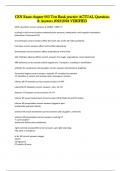CEN Exam chapter 003 Test Bank practice ACTUAL Questions
& Answers 2023/2024 VERIFIED
MAP calculation correct answers [( 2xDBP) + SBP] / 3
cushing's triad correct answers widened pulse pressure, bradycardia, and irregular respirations
(indicative of increased ICP)
chronotropes correct answers affect the heart rate at the SA node (cardizem)
inotropes correct answers affect contractility (dopamine)
dromotropes correct answers affect automaticity of the heart
ACE inhibitors adverse effects correct answers dry cough, angioedema, renal impairment
ARB (sartans) correct answers block angiotensin 2 receptors, resulting in vasodilation
antidote for vasopressor extravasation correct answers phentolamine (regitine)
Prinzmetal angina correct answers -episodic CP unrelated to exertion
-ST elevation is variant and resolves when vasospasm resolves
inferior MI ST elevation correct answers leads II, III AVF
Lateral MI ST elevation correct answers I, AVL, V5, V6
Anterior ST elevation correct answers V1-V4
inferior MI vessel involvement correct answers RCA (feeds SA and AV nodes)
inferior MI presentation correct answers Epigastric pain
bradycardia and heart blocks
anterior MI vessel involvement correct answers LAD (supplies L ventricle)
anterior MI presentation correct answers crushing CP
"I can't breathe"
Ventricular failure and arrhythmias
right ventricle-involved MI correct answers -get right sided ekg
-NO nitro or morphine`
tx for MI correct answers oxygen
aspirin
nitroglycerin
PCI within 90 mins
,beta-blockers for HTN
**reperfusion dysrhythmias are a good sign with PCI
aortic dissection BP correct answers difference of 20 mmHg or more in SBP b/t arms
aortic dissection tx correct answers #1 priority is 2 large bore IV's
maintain HR of 60-80 (beta blocker)
maintain BP of 100-120 (nitro)
post ROSC correct answers keep O2 sat 90%
CO2 35-45
SBP >90
TTM at 32-36 celsius
medications that cause prolonged QT interval correct answers erythromycin, levofloxacin, cipro
haldol
tricyclic antidepressants
sotolol, procainamide
zofran
antidote for beta blockers correct answers glucagon
pericarditis (dressler's syndrome) correct answers retrosternal cp, worse with inspiration, activity and
laying flat
relieved by sitting up or leaning forward
diffuse ST elevation in most or all leads (not contiguous)
tx is NSAIDs
hypertensive emergency/crisis correct answers SBP >180 or DBP >120
AND
evidence of impending end-organ damage
hypertensive emergency tx correct answers nitroglycerin or nitroprusside slowly to decrease bp by 25%
in first 2 hours of tx
cardiac tamponade correct answers pericardial sac accumulates excess fluid, causing obstructive shock
Beck's Triad:
muffled heart sounds, hypotension, JVD
risk factors for DVT correct answers Stasis, endothelial injury and hypercoagulability (Virchow's triad)
non-invasive positive pressure ventilation
, contraindications correct answers risk of aspiration
hypotension
succinylcholine contraindications correct answers hyperkalemia, crush injuries, renal failure, burns,
malignant hyperthermia, increased ICP, neuromuscular disorders
malignant hyperthermia treatment correct answers Dantrolene
Causes of metabolic acidosis correct answers DKA, alcoholic acidosis, shock, renal disease, diarrhea
Causes of metabolic alkalosis correct answers severe vomiting, excessive GI suctioning,
Causes of respiratory acidosis correct answers respiratory depression, hypoventiation
Causes of respiratory alkalosis correct answers hyperventilation, anxiety attack, pulmonary embolus
croup correct answers obstruction of the larynx caused by viral infection
steeple sign on X-ray
tx with racemic epinephrine
low grade fever, barky cough, inspiratory stridor
epiglottitis correct answers thumbprint sign on X-ray
high fever, drooling, dysphagia, distress
caused by bacterial infection (HIB)
"turtle sign" (leaning forward to open airway)
carbon monoxide poisoning correct answers oxyhemoglobin curve shifted to the left,
so DON'T TRUST SP02
diagnosed with carboxyhemoglobin level
tx: 100% oxygen administration until carboxyhemoglobin is <10%
ARDS (acute respiratory distress syndrome) correct answers severe hypoxemia not affected by high
concentrations of oxygen
pulmonary embolus *Priority correct answers oxygen first, anticoagulants/fibrinolytics as indicated
1st and 2nd rib fx concerns correct answers great vessel (subclavian/aorta) and lung injury
9th-12th rib fx concerns correct answers spleen and liver injury




